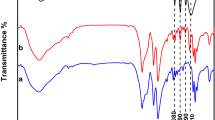Abstract
A single-stage synthesis of isoprene from methyl tert-butyl ether (MTBE) and formalin in an organic-aqueous two-phase system was studied by using solid acid catalysts, i.e., USY zeolite, silicotungstic acid (STA) 25 wt% encapsulated in MIL-101(Cr) (STA25@MIL-101), and STA 25 wt% encapsulated in SBA-15 (STA25@SBA-15). From preliminary experiments, the catalytic activity decreased in the order: STA25@MIL-101 > SBA25@SBA-15 > USY zeolite. This suggested that isoprene formation was favored with high surface area and high acid strength of catalyst. Then, the porous hybrid material of a MIL-101 metal organic framework and STA was studied in more detail. MIL-101 was not efficient for isoprene synthesis at mild reaction condition. On increasing STA loading, which was well correlated with the Brӧnsted acid property, the catalyst activity increased in the order: MIL-101 < STA30@MIL-101 < STA60@MIL-101. The high acidity catalyst gave high isoprene yield at optimum low temperature and low side reaction products. For the STA30@MIL-101 and STA60@MIL-101 catalysts, the isoprene yield could be sustained at 18.5% (0.4% SD) and 30.0% (1.5% SD), respectively over three recycling runs. It is apparent that no STA leaching from the low STA loading catalyst occurred.
Graphic Abstract










Similar content being viewed by others
References
Weitz HM, Loser E (2000) Isoprene. Ullmann’s encyclopedia of industrial chemistry. 2. Wiley, New York, pp 849–875
Ezinkwo GO, Tretjakov VF, Talyshinky RM et al (2013) Overview of the catalytic production of isoprene from different raw materials; prospects of isoprene production from bio-ethanol. Catal Sustain Energy 1:100–111
Ai M (1987) The formation of isoprene by means of a vapor-phase prins reaction between formaldehyde and isobutene. J Catal 106(1):280–286
Ivanova I, Sushkevich VL, Kolyagin YG et al (2013) Catalysis by coke deposits: synthesis of isoprene over solid catalysts. Angew Chem Int Edit 125:13199–13202
Dumitriu E, Trong On D, Kaliaguine S (1997) Isoprene by prins condensation over acidic molecular sieves. J Catal 170(1):150–160
Dumitriu E, Hulea V, Fechete I et al (1999) Prins condensation of isobutylene and formaldehyde over Fe-silicates of MFI structure. Appl Catal A 181(1):15–28
Sushkevich VL, Ordomsky VV, Ivanova II (2012) Synthesis of Isoprene from Formaldehyde and Isobutene over Phosphate Catalysts. Appl Catal A 441–442:21–29
Yu X, Zhu W, Zhai S et al (2016) Prins condensation for the synthesis of isoprene from isobutylene and formaldehyde over sillica-supported H3SiW12O40 catalysts. Reac Kinet Mech Cat. 117:761–771
Sushkevich VL, Ordomsky VV, Ivanova II (2016) Isoprene synthesis from formaldehyde and isobutene over Keggin-type heteropolyacids supported on silica. Catal Sci Technol 6(16):6354–6364
Qi Y, Cui L, Li Y et al (2018) Development a facile way to restore reactivity of deactivated phosphate catalysts for prins reaction with the assistance of carbon deposition. Catal Commun 106:11–15
Vavilov DI, Akhmedyanova RA, Liakumovich AG et al (2010) Synthesis of isoprene from 1,3-dioxolane and isobutylene. Russ J Appl Chem. 83(9):1598–1601
Burkin KE, Akhmedyanova RA (2011) Novel ecological and energy saving method of single-stage synthesis of isoprene. Chem Sustain Dev 19:531–535
Ninagawa Y, Yamada O, Renge T, et al (1986) Inventors; Kuraray Co. Ltd., assignee. Process for Producing Isoprene. US patent US Patent 4593145
Wang S-S, Yang G-Y (2015) Recent advances in polyoxometalate-catalyzed reactions. Chem Rev 115(11):4893–4962
Ivan VK (1998) Catalysis by heteropoly acids and multicomponent polyoxometalates in liquid-phase reactions. Chem Rev 98:171–198
Kim JK, Choi JH, Song JH et al (2012) Etherification of n-butanol to di-n-butyl ether over HnXW12O40 (X = Co2+, B3+, Si4+, and P5+) Keggin heteropolyacid catalysts. Catal Commun 27:5–8
Tundo P, Romanelli GP, Vázquez PG et al (2010) Multiphase oxidation of alcohols and sulfides with hydrogen peroxide catalyzed by heteropolyacids. Catal Commun 11(15):1181–1184
Sun Y, Wang H, Shen J et al (2009) Highly effective synthesis of methyl glycolate with heteropolyacids as catalysts. Catal Commun 10(5):678–681
Songsiri N, Rempel GL, Prasassarakich P (2016) Liquid-phase synthesis of isoprene from methyl tert-butyl ether and formalin using Keggin-type heteropolyacids. Ind Eng Chem Res 55(33):8933–8940
Songsiri N, Rempel GL, Prasassarakich P (2017) Liquid-phase synthesis of isoprene from MTBE and formalin using cesium salts of silicotungstic acid. J Mol Catal 439(Supplement C):41–49
Zhou Y, Chen G, Long Z et al (2014) Recent advances in polyoxometalate-based heterogeneous catalytic materials for liquid-phase organic transformations. RSC Adv 4(79):42092–42113
Janiak C, Vieth JK (2010) MOFs, MILs and more: concepts, properties and applications for porous coordination networks (PCNs). New J Chem 34(11):2366–2388
Yang H, Li J, Wang L et al (2013) Exceptional activity for direct synthesis of phenol from benzene over PMoV@MOF with O2. Catal Commun 35:101–104
Wang W, Li Y, Zhang R et al (2011) Metal-organic framework as a host for synthesis of nanoscale Co3O4 as an active catalyst for CO oxidation. Catal Commun 12(10):875–879
Wen M, Kuwahara Y, Mori K et al (2016) Enhancement of catalytic activity over AuPd nanoparticles loaded metal organic framework under visible light irradiation. Top Catal 59(19):1765–1771
Férey G, Mellot-Draznieks C, Serre C et al (2005) A chromium terephthalate-based solid with unusually large pore volumes and surface area. Science 309(5743):2040–2042
Leus K, Bogaerts T, De Decker J et al (2016) Systematic study of the chemical and hydrothermal stability of selected “stable” metal organic frameworks. Microporous Mesoporous Mater. 226(Supplement C):110–116
Qadir N, Said SAM, Bahaidarah HM (2015) Structural stability of metal organic frameworks in aqueous media—controlling factors and methods to improve hydrostability and hydrothermal cyclic stability. Microporous Mesoporous Mater 201:61–90
Buragohain A, Couck S, Van Der Voort P et al (2016) Synthesis, characterization and sorption properties of functionalized Cr-MIL-101-X (X = –F, –Cl, –Br, –CH3, –C6H4, –F2, –(CH3)2) materials. J Solid State Chem. 238(Supplement C):195–202
Wee LH, Bonino F, Lamberti C et al (2014) Cr-MIL-101 encapsulated keggin phosphotungstic acid as active nanomaterial for catalysing the alcoholysis of styrene oxide. Green Chem 16(3):1351–1357
Deng Q, Nie G, Pan L et al (2015) Highly selective self-condensation of cyclic ketones using MOF-encapsulating phosphotungstic acid for renewable high-density fuel. Green Chem 17(8):4473–4481
Zang Y, Shi J, Zhao X et al (2013) Highly stable chromium(III) terephthalate metal organic framework (MIL-101) encapsulated 12-tungstophosphoric heteropolyacid as a water-tolerant solid catalyst for hydrolysis and esterification. Reac Kinet Mech Cat 109(1):77–89
Juan-Alcañiz J, Ramos-Fernandez EV, Lafont U et al (2010) Building MOF bottles around phosphotungstic acid ships: one-pot synthesis of bi-functional polyoxometalate-MIL-101 catalysts. J Catal 269(1):229–241
Sheng X, Kong J, Zhou Y et al (2014) Direct synthesis, characterization and catalytic application of SBA-15 mesoporous silica with heteropolyacid incorporated into their framework. Microporous Mesoporous Mater 187:7–13
Rafiee E, Joshaghani M, Eavani S et al (2008) A revision for the synthesis of β-enaminones in solvent free conditions: efficacy of different supported heteropoly acids as active and reusable catalysts. Green Chem 10(9):982–989
Kurti L, Czako B (2005) Prins reaction. Strategic applications of named reactions in organic synthesis. Elsevier, Amsterdam, p 364
Adam JM, Clapp TV (1986) Reactions of the conjugated dienes butadiene and isoprene alone and with methanol over ion-exchanged montmorillonites. Clay Clay Miner. 34:287–294
Rocchiccioli-Deltcheff C, Fournier M, Franck R et al (1983) Vibrational investigations of polyoxometalates. 2. Evidence for anion-anion interactions in molybdenum(VI) and tungsten(VI) compounds related to the Keggin structure. Inorg Chem 22(2):207–216
Treacy MMJ, Higgins JB (2001) Collection of simulated XRD powder patterns for zeolites. Elsevier, Amsterdam
Maaz S, Rose M, Palkovits R (2016) Systematic investigation of the pore structure and surface properties of SBA-15 by water vapor physisorption. Microporous Mesoporous Mater 220:183–187
Canivet J, Bonnefoy J, Daniel C et al (2014) Structure-property relationships of water adsorption in metal-organic frameworks. New J Chem 38(7):3102–3111
Liu L, Wang B, Du Y et al (2015) Supported H4SiW12O40/Al2O3 solid acid catalysts for dehydration of glycerol to acrolein: evolution of catalyst structure and performance with calcination temperature. Appl Catal A 489:32–41
Qiu J, Wang G, Zhang Y et al (2015) Direct synthesis of mesoporous H3PMo12O40/SiO2 and its catalytic performance in oxidative desulfurization of fuel oil. Fuel 147:195–202
Bromberg L, Diao Y, Wu H et al (2012) Chromium(III) terephthalate metal organic framework (MIL-101): HF-free synthesis, structure, polyoxometalate composites, and catalytic properties. Chem Mater 24(9):1664–1675
Zhang Y, Degirmenci V, Li C et al (2011) Phosphotungstic acid encapsulated in metal-organic framework as catalysts for carbohydrate dehydration to 5-hydroxymethylfurfural. Chemsuschem 4(1):59–64
Maksimchuk NV, Kovalenko KA, Arzumanov SS et al (2010) Hybrid polyoxotungstate/MIL-101 materials: synthesis, characterization, and catalysis of H2O2-based alkene epoxidation. Inorg Chem 49(6):2920–2930
Canioni R, Roch-Marchal C, Sécheresse F et al (2011) Stable polyoxometalate insertion within the mesoporous metal organic framework MIL-100(Fe). J Mater Chem 21(4):1226–1233
Ribeiro S, Barbosa ADS, Gomes AC et al (2013) Catalytic oxidative desulfurization systems based on Keggin phosphotungstate and metal-organic framework MIL-101. Fuel Process Technol 116:350–357
Khder AERS, Hassan HMA, El-Shall MS (2014) Metal-organic frameworks with high tungstophosphoric acid loading as heterogeneous acid catalysts. Appl Catal A 487:110–118
Kong Y, Cheng X, An H et al (2018) Preparation and characterization of H4SiW12O40@MIL-100(Fe) and its catalytic performance for synthesis of 4,4′-MDA. Chin J Chem Eng 26(2):330–336
Bardin BB, Bordawekar SV, Neurock M et al (1998) Acidity of Keggin-type heteropolycompounds evaluated by catalytic probe reactions, sorption microcalorimetry, and density functional quantum chemical calculations. J Phys Chem B 102(52):10817–10825
Janik MJ, Davis RJ, Neurock M (2004) A first principles analysis of the location and affinity of protons in the secondary structure of phosphotungstic acid. J Phys Chem B 108(33):12292–12300
Ganapathy S, Fournier M, Paul JF et al (2002) Location of protons in anhydrous Keggin heteropolyacids H3PMo12O40 and H3PW12O40 by 1H{31P}/31P{1H} REDOR NMR and DFT quantum chemical calculations. J Am Chem Soc 124(26):7821–7828
Herbst A, Khutia A, Janiak C (2014) Brønsted instead of lewis acidity in functionalized MIL-101Cr MOFs for efficient heterogeneous (nano-MOF) catalysis in the condensation reaction of aldehydes with alcohols. Inorg Chem 53(14):7319–7333
Berry FJ, Derrick GR, Mortimer M (2014) Identification and characterisation of stable phases of silicotungstic acid, H4SiW12O40·nH2O. Polyhedron 68:17–22
Jürgensen A, Moffat JB (1995) The stability of 12-molybdosilicic, 12-tungstosilicic, 12-molybdophosphoric and 12-tungstophosphoric acids in aqueous solution at various pH. Catal Lett 34(1):237–244
Akgül G, Kruse A (2013) Hydrothermal disproportionation of formaldehyde at subcritical conditions. J Supercrit Fluids. 73(Supplement C):43–50
Bajorek JJS, Battaglia R, Pratt G et al (1974) A modified prins reaction applicable to conjugated dienes. J Chem Soc 1:1243–1245
Peel R, Sutherland JK (1974) An alternative synthesis of the corey prostaglandin aldehyde. J Chem Soc 4:151–153
Acknowledgements
This study was financially and technically supported by Bangkok Synthetics Co., Ltd. We are grateful to Dr. Steffen Hausdorf, Technische Universität Dresden, for the permission of the use of MIL-101(Cr) building block as presented in the graphical abstract.
Author information
Authors and Affiliations
Corresponding authors
Ethics declarations
Conflict of interest
The authors declare no conflict of interest.
Additional information
Publisher's Note
Springer Nature remains neutral with regard to jurisdictional claims in published maps and institutional affiliations.
Electronic supplementary material
Below is the link to the electronic supplementary material.
Rights and permissions
About this article
Cite this article
Songsiri, N., Rempel, G.L. & Prasassarakich, P. Isoprene Synthesis Using MIL-101(Cr) Encapsulated Silicotungstic Acid Catalyst. Catal Lett 149, 2468–2481 (2019). https://doi.org/10.1007/s10562-019-02837-0
Received:
Accepted:
Published:
Issue Date:
DOI: https://doi.org/10.1007/s10562-019-02837-0




